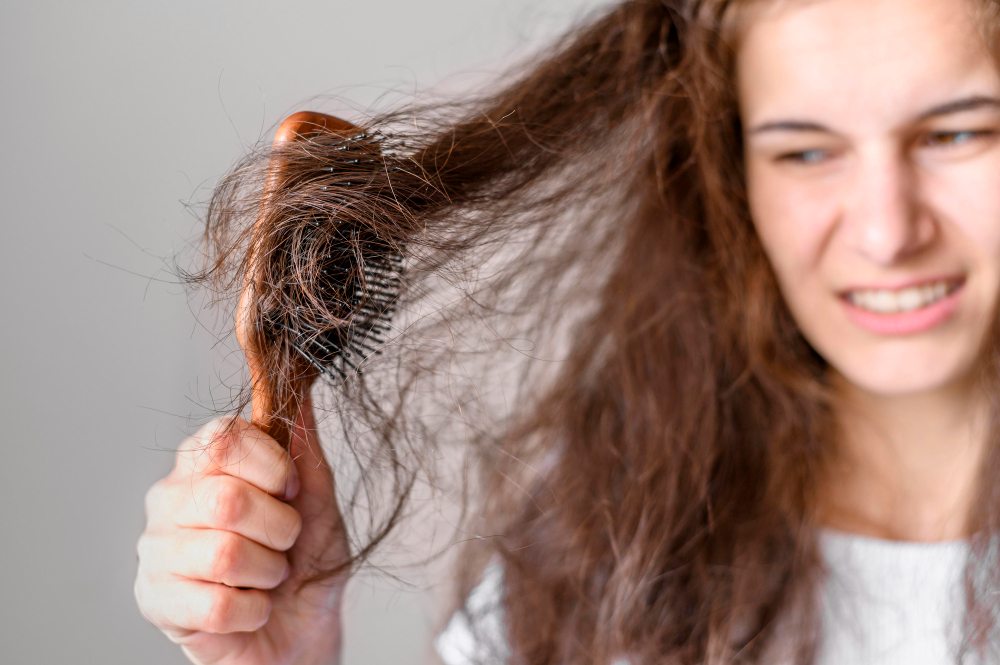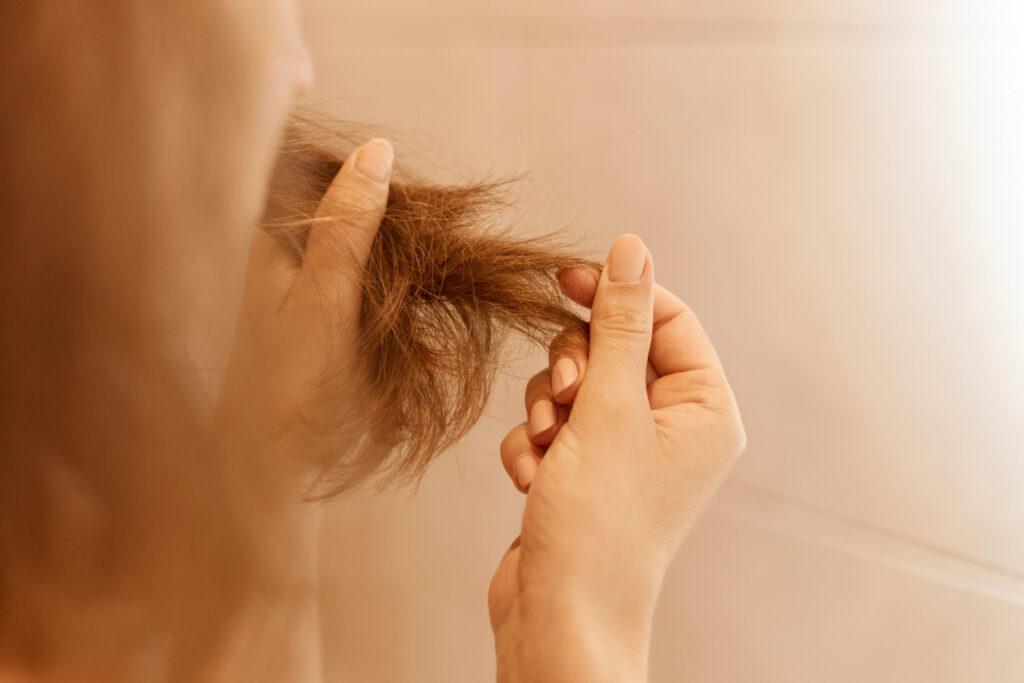Have you been blow-drying or straightening your hair a lot lately? Have you noticed how this affected your hair health? Your hair becomes dull, dry, dehydrated, and hard to manage, right? So, what should you do to fix this? in other words, how to repair heat damaged hair quickly? Following some steps can help you restore hair shine and strength without the need of using expensive products.
In this article, I will walk you through the most recommended steps on how to repair heat damaged hair. I will also include what damaged hair looks like, how to prevent heat damage, and when to consult a dermatologist.
Table of Contents
Key Takeaways:
- Heat damaged hair signs include breakage, shedding, hair loss, dryness, tangles, color fading, knots, and brittleness.
- Oil treatment, homemade hair masks, natural shampoo, a healthy diet, cutting split ends, and using hyaluronic acid are the top and most recommended steps on how to repair heat damaged hair.
- To prevent hair damage: avoid regular use of hairstyling tools, don’t overwash your hair, use heat protectant spray, dry your hair with a microfiber towel, use a satin scarf, and try hair and scalp sunscreen.
What Damaged Hair Look Like?
Using hairstyling tools frequently will definitely make changes to your hair texture and affect its health. Here are some signs of heat-damaged hair:
- Split Ends: Breakage or split ends is the first warning that tells your hair is probably damaged. Unfortunately, split ends can’t be reversed, what you should do is cut them off to get rid of unhealthy-looking ends.
- Overly Dry Hair: Excessive use of hairstyling tools strip your hair of its natural moisture. Your hair will become brittle and dry and feels rough and stringy even after using moisturizing products.
- Unmanagable Hair: Heat-damaged or chemically-damaged hair has a rough texture which makes it not easy to style and manage.
- Dull Hair: Damaged hair looks fried and super unhealthy. Plus, it will be frizzy all the time.
- Breakage and shedding: Heat-damaged hair is more prone to breakage and shedding. This happens because heat styling tools weaken the hair shaft and make your hair fragile. So, this can also lead to hair loss.
- Knots: Damaged hair becomes a tangled mess easily because it loses its moisture and elasticity and this will make it also easier to break.
- Color Fading: If your hair is severely damaged due to excessive use of hairstyling tools, it will lose its natural color over time.
How To Repair Heat Damaged Hair?

To repair heat-damaged hair and keep your hair looking healthy and lustrous, Follow the next steps:
1- Prevent Further Damage
The first and the most important step on how to repair heat damaged hair is to prevent further damage. How to do that? Easy. You will need to:
- Stop using hair straighteners and other hairstyling tools for a while.
- Deep condition your hair.
- Try an oil soak.
- Use heat protectant spray if you really need to straighten or curl your hair.
- Protect your hair and scalp against UV rays by using a scalp and hair sunscreen spray.
- Avoid bleaching or dying your hair.
Those tips will help make your hair look healthy and radiant again.
2- Get Rid Of Split Ends
Using a blow-dryer and flat iron regularly will affect your hair health, leading to visible split ends.
The first thing you should do to improve the appearance of heat-damaged hair is to get a trim. Split ends make your hair look unhealthy and fragile. They can’t be restored that’s why you will have to cut and replace them with fresh and healthy ends.
3- Go With Oil Treatments
An oil soak is one of the best solutions that nourish the scalp and hair and restore the protective outer layer of your hair.
Adding an oil soak treatment to your hair care routine can also help your roots regain their strength, combat frizz, and successfully treat damaged hair.
Hair oils include coconut oil, olive oil, ashwagandha oil, castor oil, argan oil, moringa oil, and watercress oil are recommended for damaged hair. They can moisturize hair, heal different scalp issues like dandruff, reduce frizz, and promote healthy hair growth.
But studies showed mineral oils and sunflower oil don’t help in improving the health of hair follicles.
So, how to make an oil soak? Here’s what to do:
- Massage your scalp with your preferred oil for about 5-10 minutes.
- Cover your hair with a hot towel and leave it for about 1-2 hours. This will help open up hair cuticles so the oils can penetrate deep down and improve their health.
- Then, wash your hair well with shampoo and condition your hair.
4- Use Repairing Natural Shampoo
It’s best to get rid of your shampoo if it contains harsh chemicals as they can strip your hair of its natural moisture and make your damaged hair look even worse.
You should avoid shampoos that contain sulfate, paraben, formaldehyde, synthetic fragrances, and other chemicals.
What you should use instead? Find a natural repairing shampoo that is formulated with natural ingredients like biotin, vitamin E oil, aloe vera, and glycerin. Natural shampoos contain mild surfactants that can cleanse the scalp and hair without stripping the scalp of its natural oils.
Also, avoid shampooing your hair daily as this can affect your hair health. You can instead wash your hair every other day.
5- Deep Condition Your Hair
Natural hair masks and deep conditioning treatments can restore hair texture, lock in moisture into hair follicles, and improve the look of your hair.
Making those treatments at home is often recommended as you will have control over the ingredients you wanna use.
Homemade deep conditioning treatments should contain shea butter, olive oil, coconut oil, aloe vera, avocado, or argan oil. Those ingredients can bring bouncy back to your hair, improve hair health, and keep it nourished. Deep conditioning treatments are usually more suitable for wavy and curly hair as they can help your curls regain their natural shape and prevent frizz. Curly hair masks include:
Avocado And Olive Oil Mask
You’ll need:
- Half an avocado.
- 4-7 tablespoons of olive oil, depending on your hair thickness.
Mash the avocado and mix it well with olive oil then apply the mixture to your scalp and hair and massage. Leave it for 1-2 hours then shampoo your hair. For more homemade deep-conditioning recipes for curly hair, Check out this article.
However, hair masks for straight hair should contain moisturizing lightweight ingredients like yogurt, honey, aloe vera, rose water, or olive oil. They can reduce the damage caused by hairstyling tools, moisturize your hair, and restore natural hair proteins. They can also treat brittleness and dryness. Homemade hair masks for straight hair include:
Honey and Olive Oil Mask
You’ll need:
- 2-3 tablespoons of honey.
- 4-6 tablespoons of olive oil.
Mix the ingredients well then apply the mixture to your hair from roots to tips. Leave it for 1-2 hours and wash your hair with mild shampoo. For more DIY hair mask recipes for straight hair, Check out this article.
6- Follow A Nutritious Diet

If you want to know how to repair heat damaged hair fast, the key is to consume healthy nutritious meals that can improve your overall health including your hair health.
Leafy greens, vegetables, and fruits are full of antioxidants, vitamins, and minerals that can provide your scalp with the nutrients it needs. They also have anti-inflammatory properties that can help heal inflammation and improve your scalp and hair health.
Hair is made of keratin which is a type of protein, So consuming protein-rich meals daily is essential for maintaining strong shiny hair.
Plus, nuts are rich in healthy fats and zinc that can help prevent shedding and breakage.
Consuming those foods regularly gives your hair a healthy glow-up and treats damaged dry hair effectively.
7- Try Hyaluronic Acid
Using hyaluronic acid for hair has become super popular lately. I bet you have already seen many TikTok users trying it and swear by its benefits.
They found that hyaluronic acid can combat frizz and flyaways significantly, add shine to hair, prevent dryness and brittleness, and moisturize and soften hair follicles. Plus, it’s lightweight and gets absorbed quickly into the hair shaft without leaving build-ups in the cuticle.
According to Cosmopolitan.com, hyaluronic acid is a humectant that pulls in water from the atmosphere and locks in moisture to keep your hair hydrated and nourished. And it suits all hair types and textures.
You can find it as the main ingredient in many hair care products easily on the market.
How To Prevent Hair Damage?
To keep your hair healthy and prevent hair damage, you should:

Avoid Overwashing Your Hair: Washing your hair daily can strip it of its natural oils that are essential to keep your hair soft, shiny, frizz-free, and healthy. So it’s best to wash your hair every two days or every other day to maintain your hair health.
Use Heat Protectant Spray: If you have to blow dry or straighten your hair, you must apply a heat protectant spray to damp hair to seal the cuticle, reduce breakage and frizz, and soften your hair.
Avoid Using Hairstyling Tools Regularly: You should use hairdryers and hair straighteners less frequently, about 1-2 times a month. And when blow drying your hair, hold it 5 inches away from your hair to prevent heat damage. Studies showed that this can help protect hair follicles from damage.
Turn Down The Heat: To prevent heat damage, it’s best to lower the temperature, and stay under 350°F- 375°F so you can create the style you want without damaging your hair.
Protect Your Hair Against UV Rays: Adding hair and scalp sunscreen to your hair care routine is essential as UV rays can dry your hair and make it look fried and brittle.
Use A Microfiber Towel Or Cotton T-shirt: A microfiber towel or cotton t-shirt is gentle on hair and won’t create friction that makes hair rough, frizzy, and weak. Plus, they can dry wet hair faster by soaking up excess water.
Wear A Satin Scarf: Before sleep, wrap your hair in a satin or silk scarf or sleep on a silk pillowcase. Satin or silk leaves your hair smooth and frizz-free while cotton pillowcases or scarfs absorb moisture from hair which leaves it rough, frizzy, and tangled.
When To See A Dermatologist?
If you tried those at-home treatments I included above for 1-3 months but you haven’t noticed a difference, you should consult a dermatologist or haircare specialist so he/she can make a treatment plan that guarantees the best results.
The Bottom Line
The steps on how to repair heat damaged hair are easy and simple, they will help make your hair healthy again and get your confidence back. So, check them out and let me know what you think!
Feature image source: Freepik.com/@master1305
